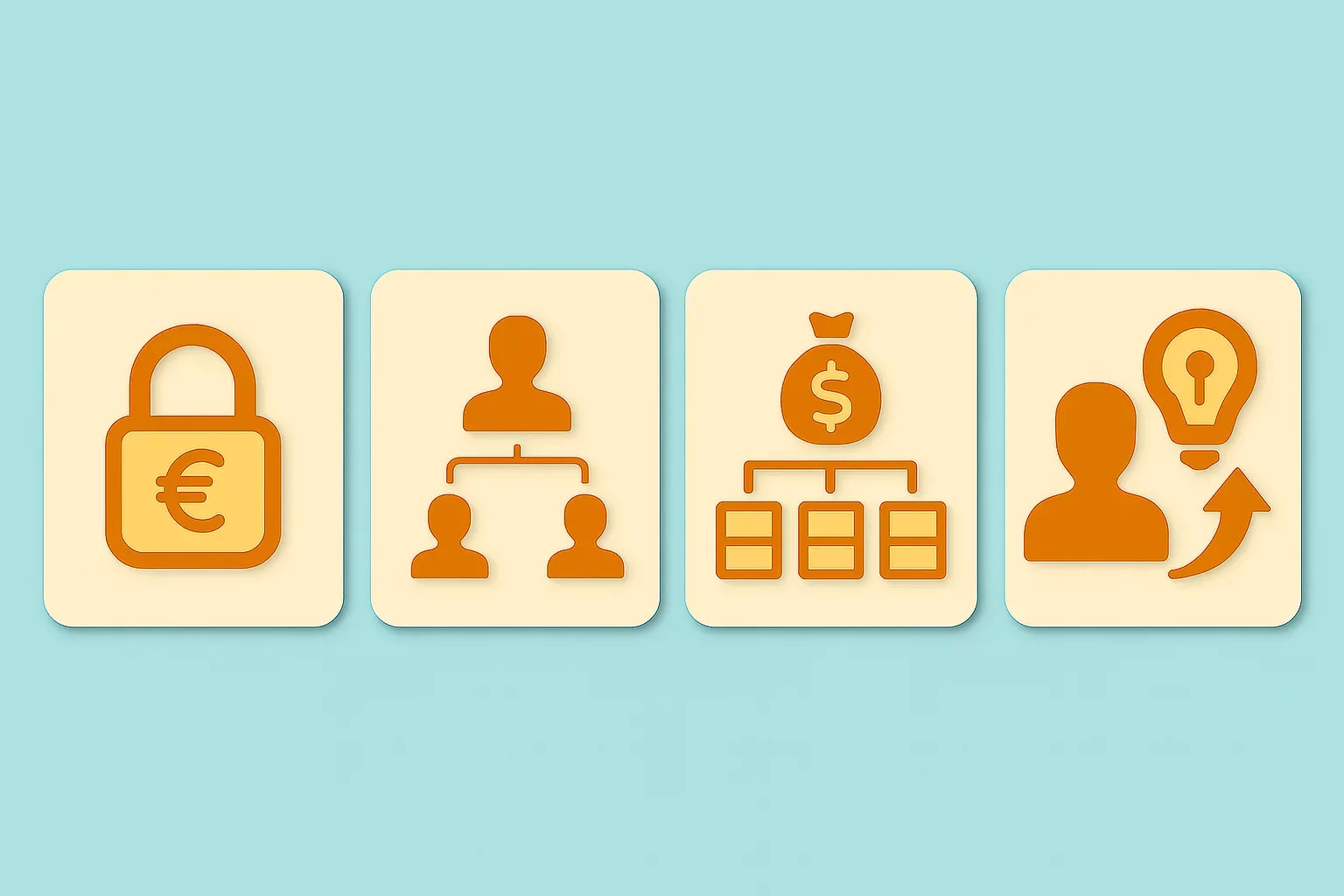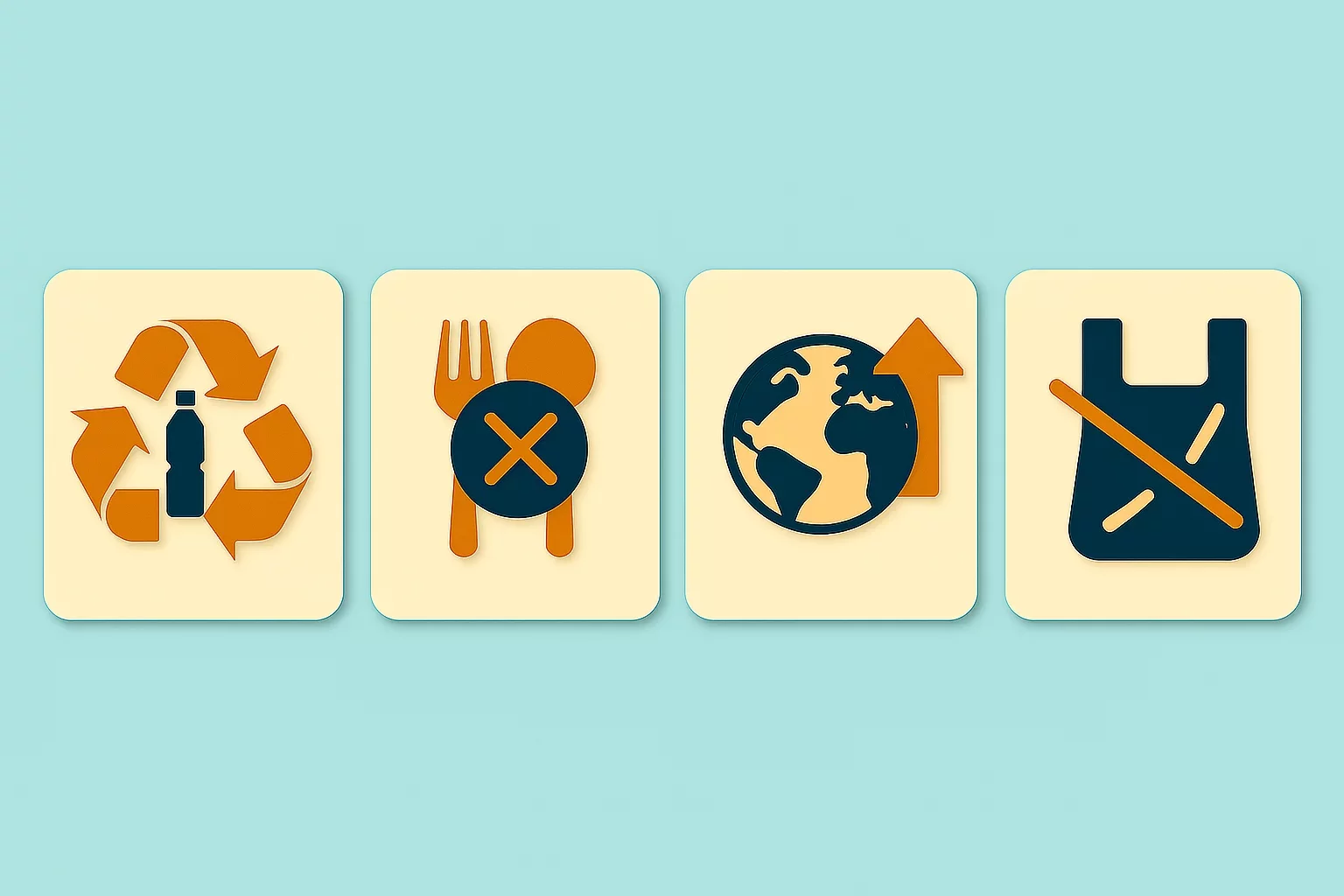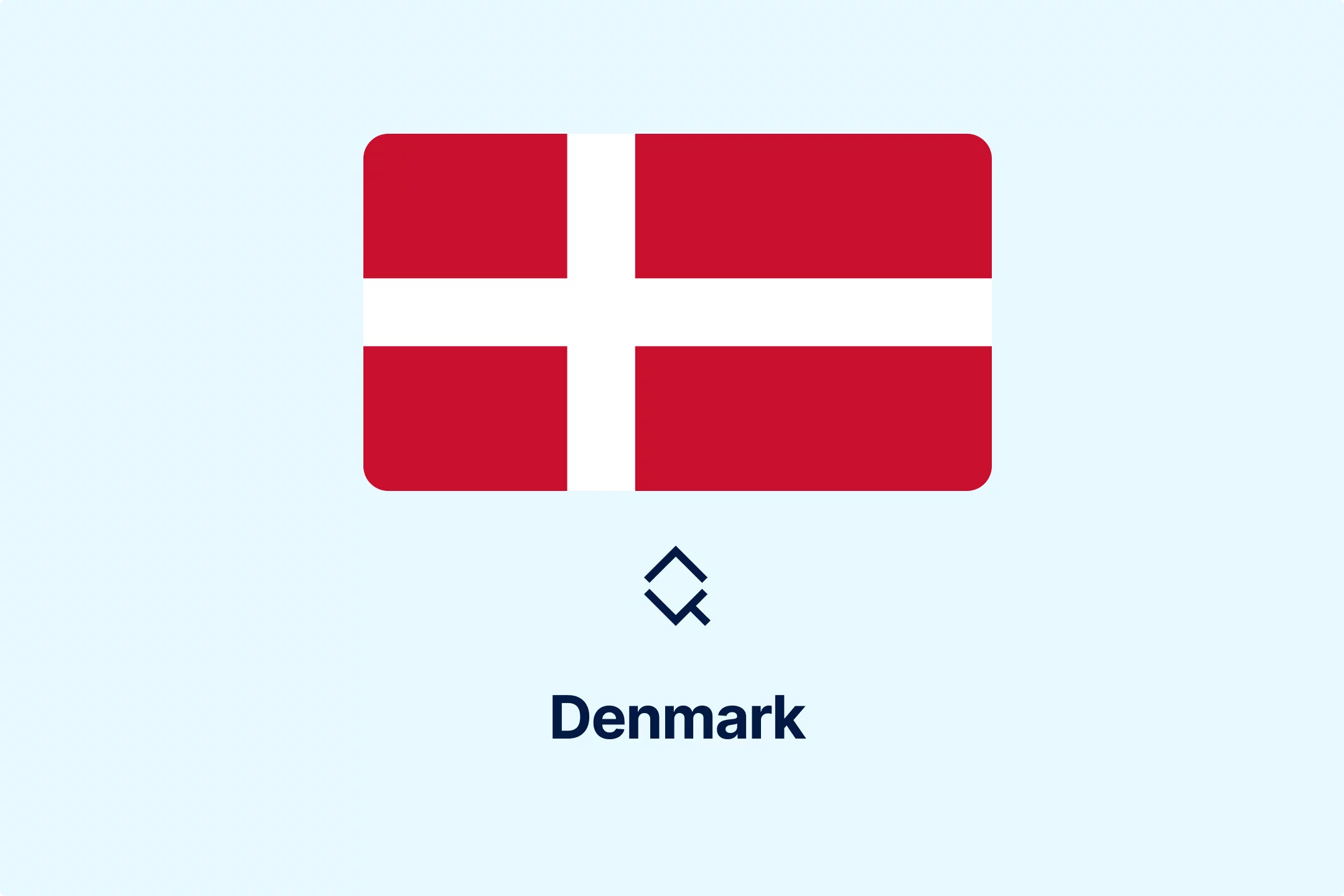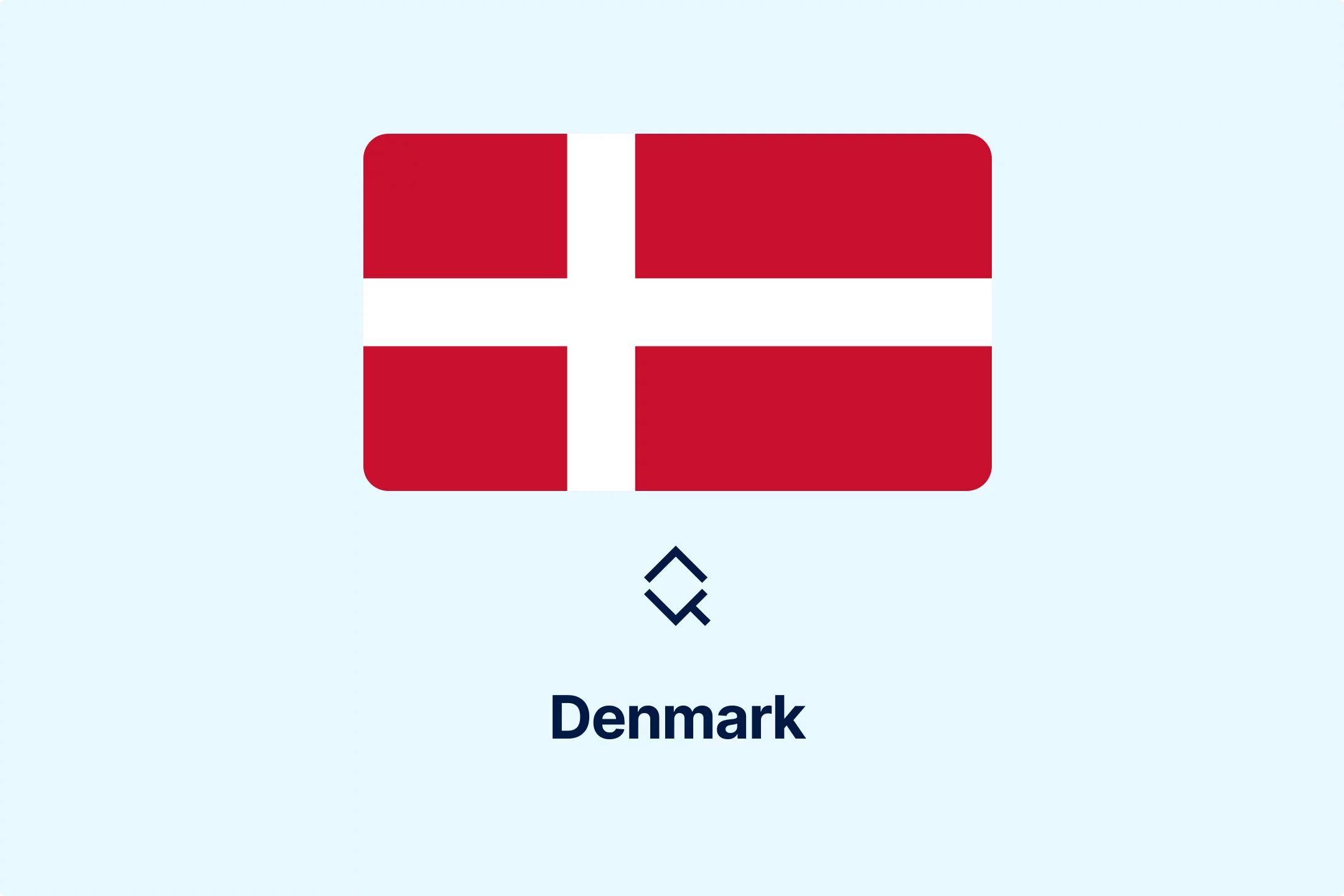Complete Guide to VAT in Denmark: Rates, Rules & Registration Thresholds

| Standard VAT Rate | Reporting Frequency | VAT Rate for ESS | Digital Reporting | Reporting Currency | |
|---|---|---|---|---|---|
| 25% | Monthly/Quarterly/Semi-annually | 25% | Resident | B2G | DKK |
| Non-Resident | B2G | ||||
VAT in Denmark - Two Types of Rates
There are two types of VAT rates in Denmark:
Standard VAT rate,
Zero VAT rate.
| Denmark VAT Rate | Type | Applicability |
|---|---|---|
| 25% | Standard VAT Rate | Applies to all taxable supplies in the country besides those subject to zero VAT rate or are exempt; |
| 0% | Zero VAT Rate | Applies to the intra-EU supply of goods(if the recipient is taxable person in MS of acquisition) and export of goods to non-EU countries. |
How Much is VAT in Denmark’s Regions?
The Kingdom of Denmark consists of three parts: Denmark, Greenland, and the Faroe Islands. However, Greenland and the Faroe Islands are self-governing regions that are not subject to Denmark VAT rules and regulations.
VAT Registration Threshold
VAT Denmark law, official guides from the Tax Administration, and data available on government websites provide essential information on the VAT registration threshold.
The regulations state that the VAT registration threshold for domestic taxable persons is DKK 50,000 in 12 months. On the contrary, the VAT Denmark rules and regulations do not include any threshold for foreign taxable persons.
EU harmonized VAT rules are implemented in the Denmark VAT legal framework, thus setting the EUR 10,000 VAT registration threshold for intra-Community distance sales of goods and B2C supplies of services. As in other EU Member States, no registration threshold applies to suppliers of electronically supplied services outside the EU.
The EU VAT SME scheme in Denmark is only available to taxable persons that do not exceed the Danish DKK 50,000 VAT threshold and the EU-wide DKK 744,750, equivalent to EUR 100,000, in the current or previous calendar year.
Types of Taxable Activities in Denmark
Several economic activities are taxable under the VAT Denmark law if performed independently by natural or legal entities. These activities include supplying goods and services on Denmark's territory for a fee, receiving reverse-charge services by a taxable person in Denmark, and exporting and importing goods.
VAT Registration Process
The VAT registration process in Denmark is completed before the Danish Tax Agency (SKAT). It includes several steps that differ slightly for domestic and foreign taxable persons, such as US businesses.
Denmark VAT Registration for Domestic Businesses
For businesses to be considered domestic, they must either be incorporated there, have essential management or central business administration, or have sufficient human or technical resources. Once domestic businesses exceed the DKK 50,000 VAT threshold in Denmark, they must register for VAT. However, they can also register for VAT in Denmark voluntarily. The process is completed in three steps.
The first step is to register the business for VAT on the government portal Virk. Once registered, the company must complete the registration form and finally accept using the government service MitID Erhverv or MitID for businesses.
Denmark VAT Registration for Foreign Businesses
The registration process for foreign businesses is similar to that for local businesses. However, foreign businesses, especially those outside of the EU, may need to provide additional documents to complete this process. In addition, non-EU businesses usually must appoint a tax representative to complete the VAT registration process and for other VAT compliance-related matters.
VAT Returns in Denmark
All taxable persons involved in VAT taxable activities and registered for VAT in Denmark must submit monthly, quarterly, or semi-annual VAT returns. VAT returns are submitted even if there are no VAT transactions. This is known as zero declaration or nulindberetning.
Mostly, taxable persons submit quarterly or every six months. The type of VAT return to be submitted depends on the annual VAT taxable revenue. Therefore, a semi-annual VAT return is due if the revenue is less than DKK 5 million. Newly established businesses and those with revenue between DKK 5 million and DKK 50 million file VAT returns quarterly. Taxable persons with annual revenue exceeding DKK 50 million submit monthly returns.
Semi-annual VAT returns are submitted at the beginning of September and March, whereas quarterly returns are submitted at the beginning of March, June, September, and December. The filing deadline for monthly VAT returns is the 25th of the month following the reporting period.
Penalties for Failure to File Tax Return
Taxable persons who fail to register for VAT, submit a late VAT return, or altogether avoid this obligation will face penalties and fines imposed by the Danish Tax Administration. Those who fail to submit their VAT returns within the deadlines receive an estimated report from the Tax Administration on their due VAT. The penalty for this, or the cost of the Tax Administration's work on estimation reports, is DKK 1,400 for each period the taxable person is late.
In addition, employees who receive public benefits may lose them and be refused further benefits if they apply. Other penalties include forced deregistration of businesses and criminal proceedings.
VAT Rules for Electronically Supplied Services
Electronically Supplied Services (ESS) are defined at the EU level by the EU VAT Directive 2006/112/EC as services provided through the Internet or other digital networks. Another critical component of ESS is its explicit reliance on automation and minimal to no human input.
As an EU Member State, Denmark implemented the definition of ESS in its national regulatory framework. By doing so, Denmark adheres to the EU principle of a single market and helps all market players more easily reach tax compliance.
However, there are some differences among EU countries regarding the ESS, mainly terminological. That is why, across the EU, several terms are used for ESS, such as digital services, digital products, and electronic services. This may cause some confusion, but refer to the same services. It is also important to note that the taxability rules for the ESS are the same as those at the EU level.
Taxability Rules for ESS:
The 2021 E-commerce package reformed the EU e-commerce and ESS landscape, uniforming rules for all EU countries. It brought significant changes and taxability rules for B2B and B2C supply of ESS and distance sales of goods.
Rules relating to the business-to-business or B2B supply of the ESS state that the place of supply is determined based on the general place of supply rules. For the B2C supply of ESS, also known as a business-to-consumer transaction, the place of supply is determined by the consumer's residency.
Regarding the distance sales of goods and ESS, the E-commerce reform introduced the EUR 10,000 threshold to determine which VAT rate is applicable. Suppliers whose annual turnover in the EU exceeds the threshold must apply the VAT rate under the destination principle. More precisely, the VAT rate of the country where the buyer is located is applicable, e.g., VAT rate Denmark.
When the suppliers remain below the threshold, they can either apply the VAT rate of their own country or register for one of the One-Stop Shop (OSS) schemes.
How much is VAT in Denmark on ESS?
The Denmark VAT rate for ESS is 25%.
E-Commerce Rules
The EU e-commerce framework underwent significant changes in 2021 when EU governing bodies implemented new rules stipulated in the EU VAT Directive. By design, these rules redefined the EU e-commerce market, influencing not only businesses in the EU but also those in third countries and territories.
One of the most notable changes is the introduction of the EUR 150 threshold for imported goods from non-EU countries in consignments. Additionally, eliminating the threshold regarding intra-Community distance sales significantly reduced financial and administrative burdens for e-commerce businesses.
Before the single EU threshold was introduced, every EU country had its own threshold. This represented a considerable challenge for all businesses, as they had to comply with the thresholds in each EU country. That is why the EU regulators decided to abolish this practice and establish the single EU-wide threshold.
On July 1, 2021, EU regulators adopted essential revisions to the VAT Directive, specifically to the sections relevant to the E-commerce sector. These changes were designed to reduce the challenges surrounding VAT compliance for businesses involved in cross-border activities.
The new rules also affected online marketplaces and digital platform operators. The EU governing official imposed new obligations and responsibilities on these operators, subjecting them to the deemed supplier rules. Under this rule, the platform operators are, in specific situations, responsible for collecting and remitting VAT from the underlying supplier.
Also, the Mini One Stop Shop (MOSS), established in 2015, has undergone significant changes, creating a more efficient, uniform reporting system known as the One Stop Shop (OSS). Besides redefining the two existing schemes, the Union and Non-Union, the third Import One Stop Shop (IOSS) scheme was introduced.
Therefore, the OSS with a broader reporting scope has three schemes:
Union Scheme,
Non-Union Scheme,
Import Scheme.
VAT EU Reporting
Taxable persons in Denmark must submit recapitulative statements, known as EC Sales List and Intrastat reports.
EC Sales List
The EC Sales List (ESL) is a type of tax return that contains all information on the supply of goods and services to another VAT-registered taxable person in an EU country. It includes information about each VAT-registered customer. The ESL is submitted electronically monthly or quarterly. If filed through the Tax Administration portal IDEP.web, it can be submitted with an Intrastat report. The usual filing frequency is monthly, and the ESL must be submitted by the 25th of the month following the reporting period.
Intrastat
Intrastat reports are statistical reports on the supply of goods to and from another EU country. The data collected through Intrastat reports are shared with European and international institutions, including Eurostat, the United Nations, and the International Monetary Fund. Taxable persons are required to file Intrastat reports if their imports from or exports to another EU country are above DKK 41 million and DKK 11.3 million, respectively.
Digital Reporting
Local Businesses
Currently, only mandatory B2G e-invoicing requirements are defined in Denmark, which are exchanged through the government portal NemHandel. This means there are no B2B or B2C e-invoicing rules or regulations in place. However, under the 2022 Bookkeeping Act, businesses must ensure their systems can send and receive e-invoices, store these and other relevant information and documents electronically, and support data exchange through a SAF-T file.
Non-Resident Businesses
The same e-invoicing rules apply for non-resident taxable persons, e.g., businesses, as they do for locals. However, starting on January 1, 2026, non-resident businesses registered for VAT purposes in Denmark and whose turnover exceeds the DKK 300,000 (around EUR 40,000) threshold for two consecutive years from activities in Denmark, starting with 2024 and 2025, will become subject to Danish digital bookkeeping requirements.

Featured Insights

Angola’s E-Invoicing Mandate: Phased Implementation Continues Into 2026
🕝 December 10, 2025
VAT Deduction and Business Succession: When Do Advisory Costs Serve the Company’s Interest?
🕝 December 8, 2025
Europe’s Plastic Fiscal Shift: Why Italy’s Plastic Tax Now Starts in 2027
🕝 December 3, 2025
The Decline of Low-Value Import Exemptions: Closing Gaps in Cross-Border E-Commerce
🕝 November 20, 2025More News from Denmark
Get real-time updates and developments from around the world, keeping you informed and prepared.
-e9lcpxl5nq.webp)




-ptzesl0kij.webp)



